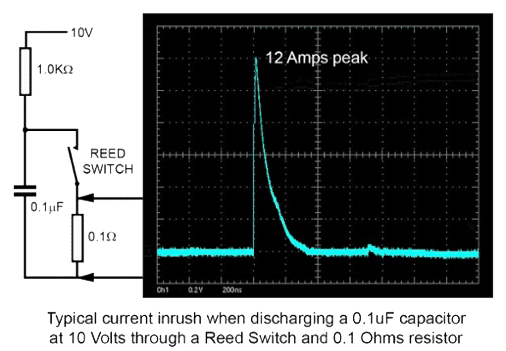Contact Abuse
Relays are sometimes considered slightly mundane and often little thought is given to them, which occasionally causes vulnerabilities. This blog post discusses contact abuse and will help you maximise the reliability of your design whilst using Reed Relays.
High current or high power inrushes are the most damaging and most frequent cause of contact damage. Reed Relays have specified maximum Current, Voltage and Power ratings. The Power figure is simply the product of the voltage across the open contacts before closure and the instantaneous current as they first make.
We at Pickering have lost count of the number of times that we have heard something like “I was only switching 5 volts at 50 milliamps onto this CMOS logic board” when the user has completely disregarded the current inrush into the liberal sprinkling of decoupling capacitors and several micro-Farads of reservoir capacitance on that board.
Do not rely on the electronic current limiting of power supplies only, to protect relay contacts. Electronic current limiting takes a finite time to react and there are often decoupling capacitors on the output of a power supply. There is nothing better than resistive current limiting.

As well as inrushes due to charging capacitive loads, discharging capacitors can be an even greater issue as the current is often only limited by the resistance of the reed switch and PC tracks. Even capacitors charged to quite low voltages can cause current inrushes of tens of amps and although they may be for microseconds only, they can cause damage to small reed switches.
As voltages increase for some applications, inrushes can become an even greater issue, for example when discharging cables after high voltage proof testing. The energy stored in a capacitance is equal to ½ CV2 Joules so will increase with the square of the voltage. Increasing from 10 volts to 1000 volts will increase the stored energy by 10,000 times.
If you have ever had a relay contact stick closed, only to free with a slight tap, or had a longer than expected release time, more than likely, it is caused by a micro-weld due to a current inrush.
For more in-depth information about the wonders that are reed relays please see our Reed RelayMate page. This educational book provides an overview of how reed relays work, how they are constructed and how to interpret their specifications and make best use of them in their applications.








